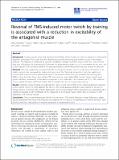Reversal of TMS-induced motor twitch by training is associated with a reduction in excitability of the antagonist muscle.
Author(s)
Giacobbe, Viola; Fregni, Felipe; Pascual-Leone, Alvaro; Krebs, Hermano Igo; Volpe, Bruce T.; Edwards, Dylan J.; Thickbroom, Gary W.; ... Show more Show less
Download1743-0003-8-46.pdf (624.1Kb)
PUBLISHER_CC
Publisher with Creative Commons License
Creative Commons Attribution
Terms of use
Metadata
Show full item recordAbstract
Background: A single session of isolated repetitive movements of the thumb can alter the response to transcranial magnetic stimulation (TMS), such that the related muscle twitch measured post-training occurs in the trained direction. This response is attributed to transient excitability changes in primary motor cortex (M1) that form the early part of learning. We investigated; (1) whether this phenomenon might occur for movements at the wrist, and (2) how specific TMS activation patterns of opposing muscles underlie the practice-induced change in direction. Methods: We used single-pulse suprathreshold TMS over the M1 forearm area, to evoke wrist movements in 20 healthy subjects. We measured the preferential direction of the TMS-induced twitch in both the sagittal and coronal plane using an optical goniometer fixed to the dorsum of the wrist, and recorded electromyographic (EMG) activity from the flexor carpi radialis (FCR) and extensor carpi radialis (ECR) muscles. Subjects performed gentle voluntary movements, in the direction opposite to the initial twitch for 5 minutes at 0.2 Hz. We collected motor evoked potentials (MEPs) elicited by TMS at baseline and for 10 minutes after training. Results: Repetitive motor training was sufficient for TMS to evoke movements in the practiced direction opposite to the original twitch. For most subjects the effect of the newly-acquired direction was retained for at least 10 minutes before reverting to the original. Importantly, the direction change of the movement was associated with a significant decrease in MEP amplitude of the antagonist to the trained muscle, rather than an increase in MEP amplitude of the trained muscle. Conclusions: These results demonstrate for the first time that a TMS-twitch direction change following a simple practice paradigm may result from reduced corticospinal drive to muscles antagonizing the trained direction. Such findings may have implications for training paradigms in neurorehabilitation.
Date issued
2011-08Department
Massachusetts Institute of Technology. Department of Mechanical EngineeringJournal
Journal of NeuroEngineering and Rehabilitation
Publisher
BioMed Central Ltd
Citation
Journal of NeuroEngineering and Rehabilitation. 2011 Aug 24;8(1):46
Version: Final published version
ISSN
1743-0003